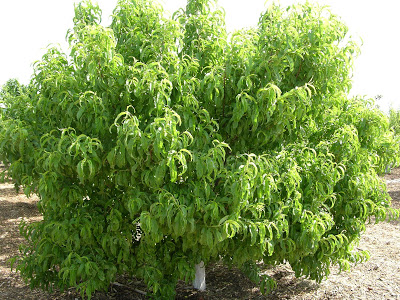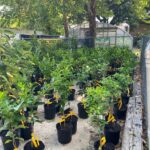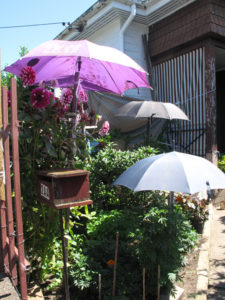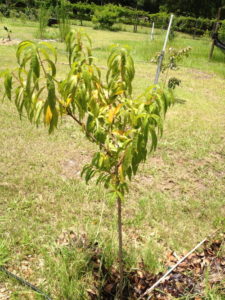
Temperate fruits are the species that are deciduous in winter. They lose their leaves and become dormant. They require a period of chilling to complete their annual fruiting cycle and they have varying degrees of winter hardiness. Apples, pears, peaches, nectarines, and plums fall into this category.
The best time to plant temperate fruit trees in during dormancy
The best time to plant temperate fruits is during the dormant season. There is little risk of transplant stress because they are in a period of rest. The energy they require to push their spring growth was stored in the roots late last summer and early fall. The roots will continue to deliver water and nutrients to the tree during dormancy and the tree will be well on its way to becoming established before the heat of summer arrives.
At one time, temperate fruit trees were only sold in their dormant state as “bare-root”. This means that they were dug from the tree lines they were grown in and shipped to the nursery without a container or soil. The bare roots had to be wrapped, or “heeled-in”, to prevent drying out during transport and storage. They had to be purchased and planted in January and February. Unsold trees were either discarded or potted up, leaving little to no variety available in the nursery.
Today, containerized fruit trees are available in the nursery year-round. This is more convenient for both the nursery and the fruit grower. The nursery can offer a consistent inventory year-round and the fruit grower can purchase trees at their convenience.
It is still best to plant during the dormant season. The cooler months of fall or early spring are next best. But what if you find yourself in the position of needing to plant when it is getting warm?
Containerized trees offer flexibility

Technically, you can plant a containerized fruit tree at any time, even during the heat of summer. However, this WILL put the tree under stress. Not maybe – definitely.
The more you can reduce that stress, the better your chances of a successful transplant. It takes a little TLC, but it can certainly be done. Follow all the steps you would normally follow for planting trees on the Upper Gulf Coast:
- Do a “perk” test to check your drainage
- Remove turf
- Decide if you need a raised bed or mound based on your perk test results
- Dig a wide, shallow hole
- Set the tree with its shoulders 2” above grade
- Use native soil back-fill ONLY for the first 1/2 of the fill (minimum)
- Use a top-fill amended with compost and expanded shale
- Apply mulch
If you just dig a hole, put the tree in it, and fill it with peat-based potting soil or bagged “garden soil”, the tree will “poach” in our heat & humidity. Literally poach. And that is just the first of the issues you will incur.
Drench the roots with half strength liquid seaweed (not fish emulsion) at the second watering. This provides minerals that reduce plant stress in the same the way electrolyte drinks replenish our bodies during heat stress. You can provide additional support by using liquid seaweed or Ocean Harvest as a foliar feed. Minerals delivered through foliar feeding are quickly absorbed through the foliage and translocated throughout the vascular system of the plant.
After planting care during heat
After planting, water thoroughly. Soak the root ball, the soil under the root ball, and the soil surrounding the root ball. After this initial soaking, do not water again for a week. A once a week, deep soaking is much better than frequent shallow watering. You want to encourage the new anchor and feeder roots to grow deep and wide to create a stable, strong, drought resistant root system. You also want the top inch or so of soil to dry out between watering. Constant wet soil combined with the heat of summer is an invitation to root rots.
Mulch also needs to be modified for trees planted during summer heat. Until the tree is established, a heavy dense mulch can do more harm than good. Use pine straw when planting in hot weather. It shades the soil and stays breathable. It does not accumulate extra heat in the new, moist soil. After the tree is established, you can add an aged woody mulch that favors the fungal colony fruit trees depend on.
The most important step - Shading

Now comes the most important step – shade the tree for at least 30–60 days. This is one of the keys to lowering stress and giving the tree a more favorable local climate while it is getting established. The shade can be provided by an old sheet, burlap, or shade cloth. A minimum of 35% is recommended, but 50% is better in our climate. The tree is still going to get a lot of light. I have seen people use dollar store yard umbrellas for a whimsical look, but I can never seem to remember to pick them up.
It must be a breathable, woven material. Anything plastic, such as a tarp, will act like a greenhouse, accumulating heat and holding it over the canopy. This is another way to “poach” the tree. Use tall stakes to suspend your shade material well above the tree so there is good airflow. When the tree is showing robust new growth, reposition the shade cloth to provide morning sun and afternoon shade to gradually increase exposure.
The practice of whitewashing the trunks is not a replacement for shading for a newly planted tree. This is a good practice for established trees, but shading is the preferred protocol for the first few months in the ground.
Fruit trees that are planted during the heat and not given this little extra intensive care will often exhibit classic signs of stress – yellowing and dropping leaves. Fruit gardeners often try to address this with extra water, which frequently makes things worse.
If you follow this simple protocol, your fruit trees will be well on their way by fall, will continue to grow over the cool months of winter, and be ready to burst with new growth the following spring.
